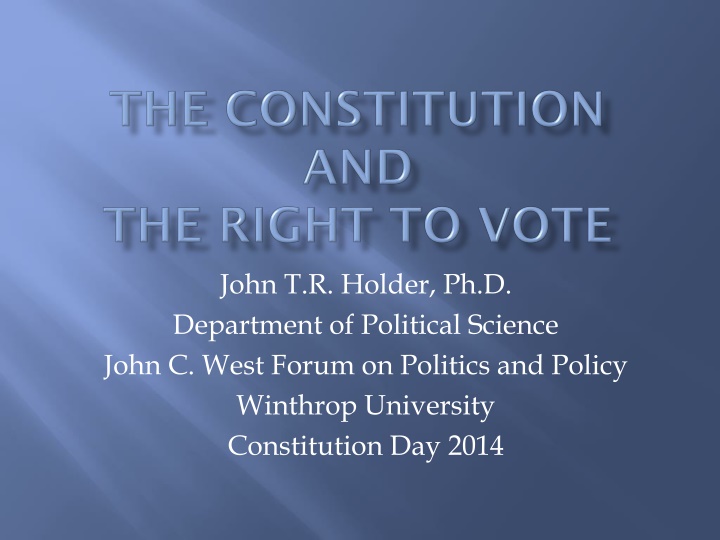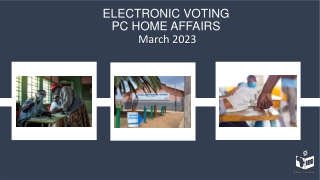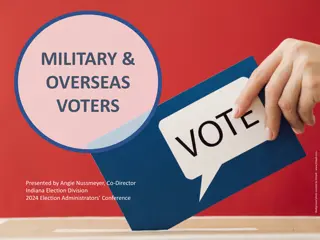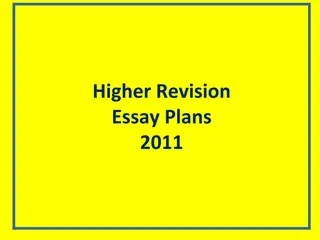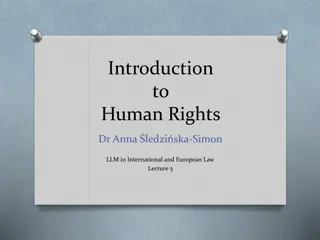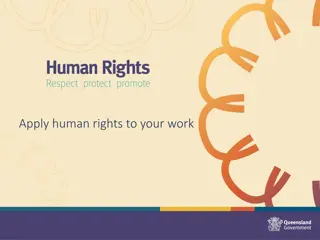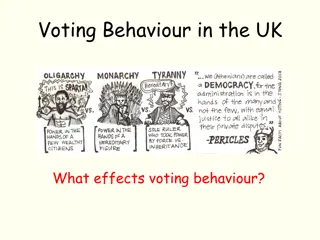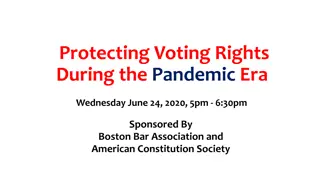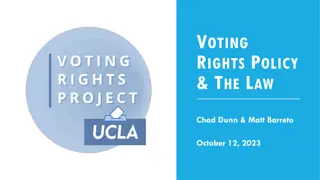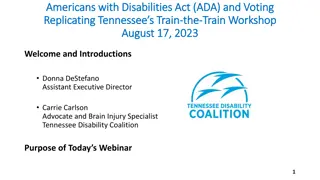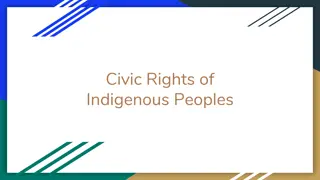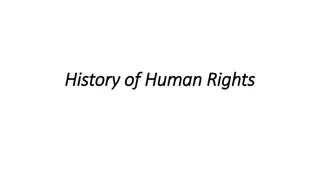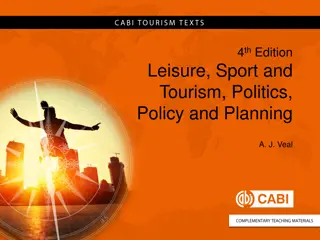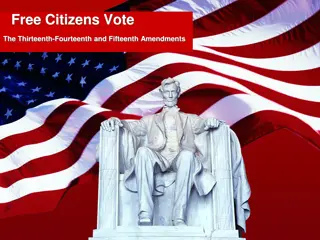Evolution of Voting Rights in the United States
The history of voting rights in the US spans various criteria for eligibility, including property ownership, race, gender, and economic status. The evolution from state-controlled voter eligibility to popular vote systems reflects the ongoing struggle for inclusive democracy.
Download Presentation

Please find below an Image/Link to download the presentation.
The content on the website is provided AS IS for your information and personal use only. It may not be sold, licensed, or shared on other websites without obtaining consent from the author.If you encounter any issues during the download, it is possible that the publisher has removed the file from their server.
You are allowed to download the files provided on this website for personal or commercial use, subject to the condition that they are used lawfully. All files are the property of their respective owners.
The content on the website is provided AS IS for your information and personal use only. It may not be sold, licensed, or shared on other websites without obtaining consent from the author.
E N D
Presentation Transcript
John T.R. Holder, Ph.D. Department of Political Science John C. West Forum on Politics and Policy Winthrop University Constitution Day 2014
Under the Articles of Confederation, the states retained control of the eligibility of voters. The original Constitution simply provided that anyone who was qualified to vote for the most numerous branch of the state legislature was eligible to vote for members of the U.S. House of Representatives, which was the only part of the national government originally chosen by popular election. But the states retained the power to decide who was eligible to vote for state and local office.
State legislatures have the authority under the Constitution to determine how their state s electors for President and Vice President are chosen. In the beginning, most legislatures chose the electors themselves, with no popular election. South Carolina did not hold popular elections for members of the Electoral College until after the Civil War.
While every state (and Washington, DC) now provides that electors are chosen by popular vote, there is still no explicit Constitutional right for individuals to vote for President and Vice President. The Florida Legislature could have resolved the 2000 election controversy simply by passing a state law naming a particular group of people to cast the state s electoral votes.
Economic status Many states restricted voting to property owners or taxpayers until the mid-19th Century. Poll taxes existed in many areas until the 1960 s. Religion Non-Protestants were barred from voting in some states prior to the ratification of the Constitution.
Race and ethnicity Slaves were not citizens and had no voting rights. Voting was restricted to whites even in some states without slavery. Many Native Americans/American Indians were not citizens and could not vote.
Gender Women could vote in New Jersey until it was explicitly prohibited in 1807. Some areas allowed women to vote in some (but not all) 19thCentury elections (example: school board elections). The Territory of Wyoming was the first U.S. jurisdiction to grant women universal voting rights in 1869.
The Territory of Utah gave women the right to vote in 1870, but it was subsequently repealed by Congress (which could overrule territorial laws). When Utah sought statehood in 1896, one of the conditions set by Congress was that women could not be given the right to vote.
Utah agreed to this restriction, was admitted to the Union, and then gave women the right to vote (since the Constitution gives the states the power to set the qualifications for voters, there was nothing Congress could then do about it).
Citizenship status and residency During the large wave of immigration in the mid-19thCentury, many states adopted lengthy residency requirements which prevented newly naturalized citizens from voting for several years after their arrival in the U.S. Other states, predominantly in the Midwest, sought to encourage settlement by extending voting rights to immigrants even before they became citizens.
Citizenship status and residency Until the 1960 s, many states required residency of one year before becoming eligible to vote. This disenfranchised mobile workers (who tend to be younger and poorer than average). In 1970, the Supreme Court ordered a maximum residency requirement of 30 days for voting in presidential elections.
The 15thAmendment (1870) barred discrimination in voting on the basis of race, color, or previous condition of servitude [slavery]. The 14th(1868) and 15thAmendments are the first time the right to vote is explicitly mentioned in the Constitution. The 17thAmendment (1913) provided for the popular election of U.S. Senators. The 19thAmendment (1920) barred discrimination in voting on the basis of sex.
The 23rdAmendment (1961) gave residents of the District of Columbia representation in the Electoral College. The 24thAmendment (1964) abolished the poll tax in federal elections. A Supreme Court decision in 1966 abolished it for state elections. The 26thAmendment (1971) lowered the voting age to 18 nationally; it was 21 in most states. Now, almost all citizens 18 and older have the right to vote in all elections.
After the former Confederates regained control of Southern state governments in the late 19th Century, they sought to disenfranchise former slaves and other African American citizens, as well as many poor whites. Poll taxes (which had to be paid retroactively) disenfranchised those who could not afford to pay them. South Carolina had an eight box law. There was a separate ballot and ballot box for each office up for election. Placing your ballot in the wrong box disqualified your vote. This disenfranchised many poorly educated people of both races who could not read the box labels.
White primaries The Democratic Party was organized as a private club. Membership was restricted to whites. Membership in the club was required to participate in its activities, including voting in the Democratic primary, which was the decisive election in most of the one-party South. This was outlawed by the Supreme Court in 1944.
Literacy tests Requiring voters to prove the ability to read and write in English had been used as early as the mid- 19thCentury to prevent immigrants from voting. Many Southern states adopted literacy requirements which could be judged at the discretion of the local voting registrar. In most cases, this involved being able to read and interpret a section of the U.S. or state Constitution. The local registrar had a great deal of power to decide whether applicants passed or failed.
Alabama: http://www.ferris.edu/htmls/news/jimcrow /origins/images/al_literacy.pdf Louisiana: http://www.tn.gov/tsla/exhibits/blackhistor y/pdfs/Voter%20Test%20LA.pdf
The Congress shall have the power to enforce this article by appropriate legislation. 15thAmendment Section 2 suspended the use of literacy tests nationwide. Section 3 provided for federal voting registrars in areas with evidence of voting discrimination based on race. Eligible black voter registration: Mississippi: 6.7% in 1964, 59.8% in 1967 Alabama: 66,000 in 1960, 273,000 in 1968
Section 5 required electoral jurisdictions which used literacy tests or similar devices, and which had less than 40% turnout of eligible voters in the presidential election of 1964, to obtain the approval of the Civil Rights Division of the U.S. Department of Justice, or the U.S. District Court for the District of Columbia, before changing any electoral procedures ( preclearance ). The Supreme Court upheld the VRA in 1968.
1970: Permanently eliminated literacy tests. Changed the preclearance formula based on turnout of eligible voters in the 1968 presidential election. 1975: Added language minorities to those protected against discrimination. Required that jurisdictions where more than 10% of the population primarily speaks a language other than English must provide balloting materials in that language.
1982: Changed the legal standard so that it was no longer necessary to prove discriminatory intent, but merely discriminatory effect, to challenge a procedure under the VRA. Renewed the Act for 25 years. 2006: Renewed the Act; the preclearance provisions were struck down by the Supreme Court in 2013 on the grounds that long-ago discrimination could not be used as the basis for determining whether a jurisdiction had to have Justice Department approval to change its election practices.
(Data as of 2009): 5.85 million ex-felons are ineligible to vote after their criminal sentences have been served 7.7% of black adults nationally, 23% in Florida In Florida, Iowa, Kentucky and Virginia, disenfranchisement is permanent after any felony conviction In Arizona, it s permanent after a second felony conviction In Nebraska, it lasts until 2 yrs. after probation is completed
In AL, MS, NV, TN, and WY, disenfranchisement is permanent after conviction for at least some types of felonies In CA, CO, CT and NY, you have no voting rights while on parole In 31 states incl. SC, you have no voting rights while on parole or probation for a felony In ME and VT, you can vote while in prison
(Data as of 2007) In seven states, people who have been judged mentally incapacitated automatically lose the right to vote. In 37 states, these people may lose the right to vote under certain circumstances. Is this a violation of their Constitutional rights, or a safeguard against their votes being fraudulently cast?
32 states have laws requiring voters to present some form of identification at the polls. As of 2013, South Carolina requires a state-issued photo ID. Photo ID laws have been upheld by the Supreme Court despite claims that they are discriminatory Poor people are less likely to have access to the documentation needed to get photo ID African Americans born prior to the Civil Rights Act of 1964 are less likely to have been born in a hospital and therefore less likely to have a birth certificate
Academic research indicates that very little vote fraud takes place in the form of identity impersonation at the polls on Election Day (which is what ID laws would combat) Minnesota has prosecuted two cases of identity impersonation in voting since 1986. An estimated 11% of eligible voters do not have government-issued photo ID; it is argued that the number of eligible voters disenfranchised by these laws far exceeds the number of cases of potential fraud that are prevented.
The Supreme Court ruled in 1979 that a dormitory qualifies as a residence for voting eligibility purposes. Many states require that voters register at their principal legal residence (for most college students, their home rather than their dorm). Some jurisdictions allegedly require a higher standard of proof of residence from college students than from others.
In Texas, a student ID card from a state university does not meet the state-issued photo ID requirement for voting. However, a concealed-carry weapons permit does. In 2013, a North Carolina county elections board tried to have a college student disqualified from running for City Council where he attended school, on the grounds that living in the dorm did not meet the residency requirement. He challenged the ruling, won the case, and then won the election.
Alexander Keyssar, The Right to Vote: The Contested History of Democracy in the United States, Revised Edition, New York: Basic Books, 2009. Thank you!
